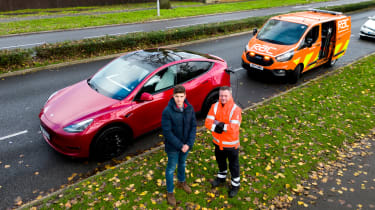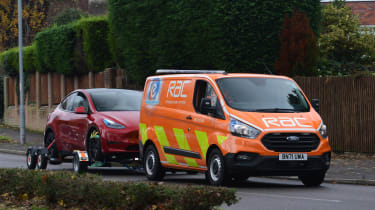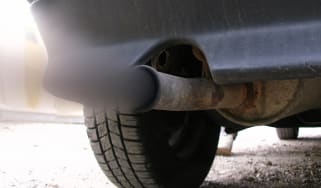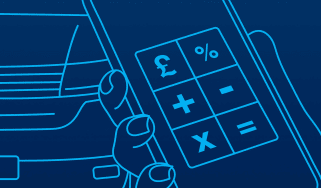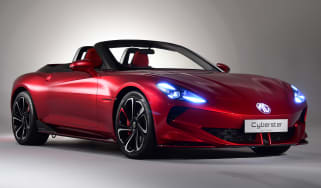Electric vehicle breakdowns: we go on EV patrol with the RAC
We join the RAC to find out how its patrols are adapting to the brave new world of electric vehicles with the latest technology designed to get stranded EV drivers back on the road
Anyone who’s ever broken down knows it’s an unpleasant – sometimes alarming – experience. Depending on where you are and how far your nearest recovery patrol is, you could spend hours waiting at the side of the road, possibly in foul weather conditions next to a busy highway if you’re particularly unlucky. That’s all before you have to worry about how bad a state your car’s in and how much it will cost to put right.
That’s why it’s so important for breakdown companies to be as efficient as possible and innovate to find new ways of rescuing stranded motorists. The RAC is one of the biggest names in the business, and its orange vans are a common sight on roads all around the UK.
Having been around since 1897, the organisation is well placed to observe the changing landscape of British motoring and adapt to new trends. And of course, one of the biggest changes in recent years has been the increasing adoption of electric vehicles. To tell us more about its work, the RAC invited us to its headquarters in Walsall, near Birmingham, to give us a demonstration.
One of the phrases that often crops up in relation to EV ownership is ‘range anxiety’. Indeed, with public charging infrastructure still spread thinner than it should be, many drivers are worried about the prospect of running out of juice on a long journey.
This is something that the RAC has considered, and the firm has now launched a new piece of kit that allows electric cars to be topped up at the roadside.
“We wanted a solution for our EV customers that didn’t just involve picking up the vehicle and moving it,” explains James Gibson, the RAC’s head of technical. “A 50kWh battery pack weighs about 700kg, which is a lot to carry around in the back of a van just in case you need it, so I challenged the team to find an alternative.”
The end result is EV Boost, which uses the engine on a standard RAC patrol van to generate electrical power via an alternator that can then be used to add some mileage to a stricken EV.
We don’t just want to hear about this, however; we need to see it in action. Fortunately, the RAC is happy to oblige. Our test car for this demonstration is a Tesla Model Y – not because it has a propensity for breaking down (far from it), and it’s not an EV that’s likely to run out of range, either, given the 331-mile capability of the Long Range model we’re using for the demonstration.
Nevertheless, we stop at the roadside near the RAC’s offices pretending to have got our mileage calculations totally wrong. Chris Fellows, one of the RAC’s technical services managers, who used to be a patrolman, is kind enough to slip back into his old role and go along with our stranded motorist act.
Opening up the back of his orange van, the only clue to EV Boost’s presence is a box with on and off buttons and a digital read out. Chris feeds a cable from the van to our Tesla’s charge port, and with the engine running in his van, he then boots up EV Boost. Immediately the Model Y’s display shows that range is being added.
The RAC has been fitting EV Boost to more of its vans and increasing its charging rate, too. More than 200 patrols are currently fitted with 5kW charging capability, while a 7.5kW version is on the way.
EV Boost adds around 10 miles of range in 30 minutes. This doesn’t sound like a huge amount, but the point isn’t to get the car back to 100 per cent. All that’s required is enough range to get the vehicle to a public chargepoint; there, it can add a more significant amount of range at a faster rate.
You might ask why it wouldn’t be quicker for an EV with a flat battery to simply be towed to a charger. Unfortunately, electric cars can’t be towed with two wheels off the ground in the same way that front or rear-wheel-drive petrol and diesel cars can. Much like four-wheel-drive cars, EVs need to have all four wheels off the ground.
Aside from EV Boost, however, the RAC has another solution for transporting broken-down EVs – and one that works with any four-wheel drive model. It’s called RDT, which stands for Rapid Deployable Towing. James gives us the brief.
“The first version of RDT launched in 2001 and we’re on version eight now,” he says. “It allows for bigger tyres and the weight tolerances are better – the original could only manage 950kg, but cars have become heavier with more SUVs and EVs. Without RDT, we would have to use flatbed trucks every time a 4x4 broke down. RDT was adapted from a US design. After we’d made modifications, we spent 18 months refining it at the MIRA test centre.
“The Mk3 is quite light – the heaviest part on it is 15kg. It can be deployed in a reasonable amount of time and saves our customers having to wait around for a second vehicle to attend, so we could resolve more cases.”
Again, this is something we want to see in action, so after demonstrating EV Boost on our Tesla, Chris shows us how he would transport the car with the RDT.
It’s a thoroughly impressive bit of kit. The yellow metal framework folds out from the back of the van to form a large structure – it’s as though the van is bigger on the inside, but in reality RDT has simply been designed well enough to fit into a neat, compact storage format.
Getting a car on to the RDT is a bit more involved; Chris spends some time assembling the various components and making sure everything fits perfectly. Although this illustrates why EV Boost is a more straightforward option for getting an EV moving again, it’s clearly much quicker to deploy RDT than it is to wait for a flatbed truck.
And with more than 1,600 RAC patrol vans packing this handy invention, it’s something that’s likely to make a lot of difference to those who find themselves in the unfortunate position of being broken down.
How to avoid a call-out to an EV in the first place
Innovations such as the RAC’s EV Boost are designed around the possibility that electric car drivers will sometimes find themselves stranded with a drained battery, so range anxiety must be a valid fear in order to warrant it.
However, EV evangelists will often say that this anxiety shouldn’t be an issue, and that only human error could allow you to run out of range.
The truth is that anyone who has experienced an EV on a long journey has a different story to tell about public charging. Some EV owners have always had good luck with the network and never come across a problem. Others have had to queue for a charge at busy motorway service stations or arrived at a unit to find it’s broken.
The best advice if you’re new to electric motoring and worried about taking a long journey is to leave plenty of time and have plans for where you’re going to top up en route – as well as back-ups in the event that those chargers have a problem.
Have you ever broken down in your EV? Tell us about your experience in the comments section...

